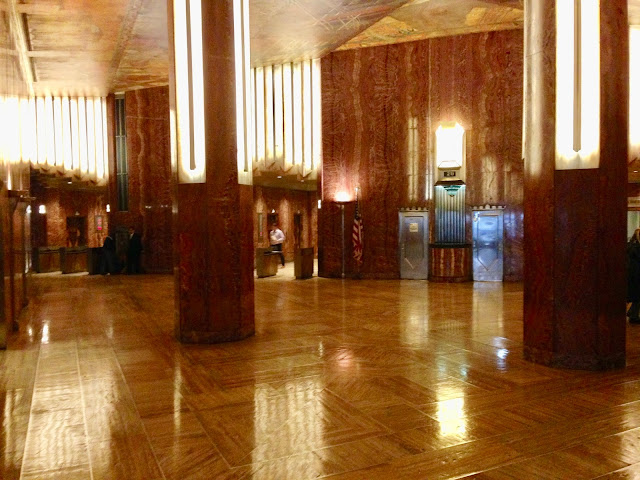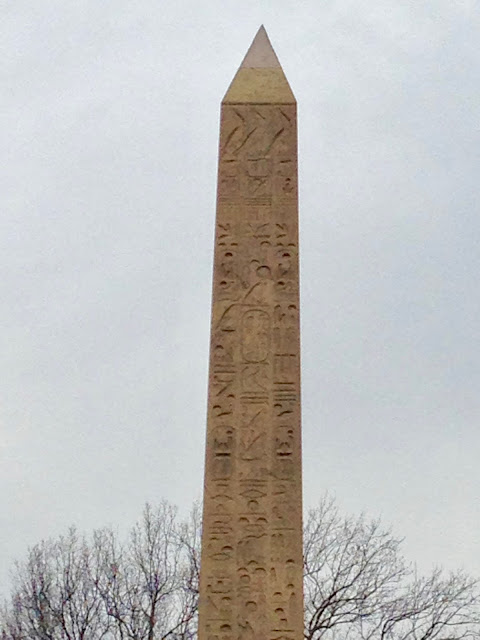If you're standing at East 42nd Street and Lexington Avenue, the northeast corner seems to have just another midtown office building.
Until you look up, above the crowds and traffic, and see that the building keeps going up and up and at the top is the famous design that sits atop the Chrysler Building, a landmark of Manhattan.
The Chrysler Building might generally be on the second tier when listing the iconic structures of New York City, after the Empire State Building, Brooklyn Bridge, and Statue of Liberty, for example. But New Yorkers (at least the ones I know) generally consider it their favorite and perhaps the most beautiful building in the city.
The building is certainly iconic and will be put on any such list, but the Empire State Building is after all a little taller, has a cooler name and had a giant ape climb it. But on substance the Chrysler Building hold its own, looking elegant and classic in all its Art Deco glory.
Also, its name isn't so bad since the Chrysler company didn't pay for the naming rights like a modern sports arena but instead its 1928-1930 construction was actually funded by Walter P. Chrysler, the founder of the company. Incidentally, he paid for construction himself so that he could pass it on to his children. It was the Chrysler Corporation's headquarters from 1930 to the mid-'50s but it never owned the building, which was the tallest in the world for 11 months until the Empire State Building was completed in 1931.
Perhaps another strike against the building, at least for tourism, is that only the lobby is open to the public since it is a fully operational business building. I would imagine that this keeps it from having a greater status among visitors, but maybe the demand wouldn't be there anyway: after you go to the top of the Empire State Building, how many more buildings do you need to go up for the view?
The Chrysler Building's lobby, though, is definitely worth a visit if you're in the area (only one subway on the east side also doesn't help for accessibility). There is beauty in all its details, from the lights along the walls to the mail slot and elevators made from several different types of wood.
The elevators are not accessible to the general public, but even from that outer view they are stunning to look at.
There is also a big mural that spans the entire lobby ceiling, Transport and Human Endeavor by Edward Trumbull. Part of it shows the exterior of the Chrysler Building, along with a nearby compass and scenes of laborers hard at work. It also shows airplanes flying across oceans and continents, including the Spirit of St. Louis, which was flown by Charles Lindbergh from Long Island to Paris in May 1927 as the first non-stop solo flight across the Atlantic.
As you might expect, the entrance on Lexington Avenue is also very impressive.
There are also two elegant side entrances that go to 42nd and 43rd Streets, though they are not quite as grand as the main entrance.
Although only the lobby is open to the public, the Chrysler Building is certainly worth a visit and should not be forgotten on the list of New York icons.
Despite the catchy name of this ancient Egyptian obelisk, Cleopatra's Needle has nothing to do with Cleopatra. It was built around 1425 B.C.E., over one thousand years before her time. It stands prominent but elusive in its Central Park spot, up on a hill just next to the Metropolitan Museum of Art and yet without a direct walking path to it from the museum, which is to the right in this photo:
Because of the roundabout paths that must be taken to reach the obelisk, its area is usually empty, with only the occasional tourist seeming to accidentally wander by and wonder What's going on here?
When I visited on a recent afternoon there was one other person checking it out, who left soon and gave me the place to myself.
Contrast that with the ancient Egyptian room in the Met that is great to visit and explore but certainly will have crowds joining you. It's a shame that the obelisk is just feet away from the museum and yet practically forgotten, especially considering that it is the oldest public monument in the city.
It is also just steps away from the Great Lawn on its other side, which possibly gives it some more foot traffic during the warmer months.
Shortly after I arrived and started taking photos and reading the plaques, small numbers of tourists started to show up, never exceeding four or five overall but still suddenly seeming like a lot.
Just at the top of the steps leading to the obelisk is a plaque full of interesting information, including history and dimensions and recent conservation efforts to revitalize the structure.
This obelisk is one of two that was built in Heliopolis at the Temple of the Sun (the other one is now in London). Pharaoh Thutmose III had it built, and the hieroglyphs on its four sides praise him and later rulers as well.
There is a plaque at the base of each side that translates what is written. Here is a brief sample of one plaque:
The Horus, Strong-
Bull-Son-of-Ra,
the King of Upper and
Lower Egypt,
User-maat-ra, Chosen-
of-Ra, he of the Two
Goddesses,
Protector-of-Egypt-and-
curber-of-foreign-lands,
the Son of Ra,
Ramesses Beloved-of-
Amun, a king excellent
like Ra,
...
That's the basic feel of all the translations. Thanks to restoration efforts by the Central Park Conservancy in 2011, a lot more of the hieroglyphs can now be seen. The process included use of lasers that removed dirt without touching the actual object. Experts say that the eroded parts of the hieroglyphs were not affected by recent wear and tear, but rather by moisture that it was exposed to for hundreds of years when it had fallen over and was semi-buried in Egypt.
The recent restoration effort occurred shortly after a warning from Egypt that it would take back the obelisk if it were not taken better care of. This detail is not included on the plaque at the site.
A true obelisk, such as this one, is carved from one stone. Most modern obelisks, for example the Washington Monument, are made from numerous stones put together. Carving it from one stone seems like more of an accomplishment, especially considering that this granite obelisk weighs 220 tons.
Upon close inspection of the obelisk, the first feature that jumped out was naturally the hieroglyphs, but soon after I noticed lobster claws sticking out from the base.
This was confusing and amusing, as Walt Frazier might say. I soon learned that they are actually crabs and were added by the Romans because of damaged corners, along with the limestone steps at the bottom, when they discovered the fallen obelisks around 12 B.C.E. and transported them to a temple honoring Julius Caesar in Alexandria, Egypt.
The original bronze crabs from the Romans are now in the Met and replicas are on the obelisk, which explains why I thought they looked surprisingly good for being thousands of years old.
In the 19th century, Egypt was gifting artifacts to European countries to help diplomatic relationships. The Khedive of Egypt offered this obelisk to America in 1869 for the same reason, and its transport took so much planning and effort that it didn't arrive in its current spot in Central Park until 1881.
And here it stands, waiting for just a visitor or two. It doesn't ask for much.



























